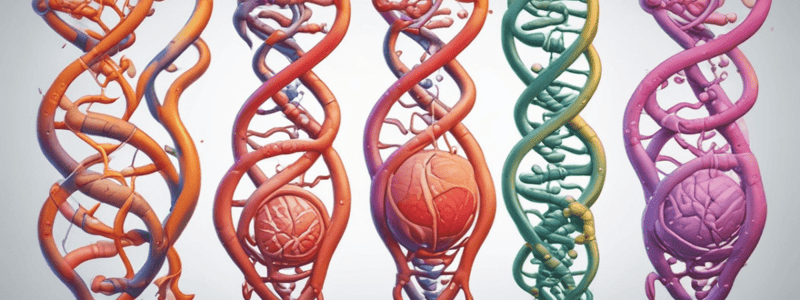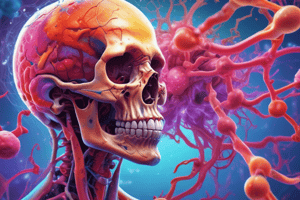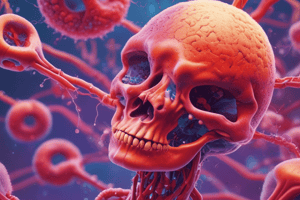Podcast
Questions and Answers
In X-linked inheritance, what is the chance of affected sons when a heterozygous carrier female parent mates with a normal male parent?
In X-linked inheritance, what is the chance of affected sons when a heterozygous carrier female parent mates with a normal male parent?
- 100%
- 75%
- 50% (correct)
- 25%
Which type of mutation involves changes in chromosome structure or number?
Which type of mutation involves changes in chromosome structure or number?
- Point mutations
- Chromosomal mutations (correct)
- Substitution mutations
- Insertion mutations
What is the genetic implication related to the treatment of genetic disorders?
What is the genetic implication related to the treatment of genetic disorders?
- Social implications
- Genetic testing
- Gene therapy (correct)
- Ethical considerations
Which of the following disorders is an example of an autosomal recessive disorder?
Which of the following disorders is an example of an autosomal recessive disorder?
Why is there no father-to-son transmission in all sex-linked inheritance?
Why is there no father-to-son transmission in all sex-linked inheritance?
What is the probability of parental consanguinity if the genetic trait is rare in the population?
What is the probability of parental consanguinity if the genetic trait is rare in the population?
What is the key difference between the inheritance patterns of autosomal recessive disorders and X-linked disorders?
What is the key difference between the inheritance patterns of autosomal recessive disorders and X-linked disorders?
What is the key difference in the enzyme function between homozygotes and heterozygotes for autosomal recessive disorders?
What is the key difference in the enzyme function between homozygotes and heterozygotes for autosomal recessive disorders?
Which of the following is an example of an X-linked disorder?
Which of the following is an example of an X-linked disorder?
What is the key difference between point mutations and chromosomal mutations?
What is the key difference between point mutations and chromosomal mutations?
Which component of genetics is described as a double helix structure containing genetic information?
Which component of genetics is described as a double helix structure containing genetic information?
How many pairs of homologous autosomes does a typical normal human cell contain?
How many pairs of homologous autosomes does a typical normal human cell contain?
Which pair of chromosomes carries matching genetic information?
Which pair of chromosomes carries matching genetic information?
In a chromosome, DNA is composed of how many complementary chains of deoxynucleotides?
In a chromosome, DNA is composed of how many complementary chains of deoxynucleotides?
Where in a chromosome is DNA bound to histones and other proteins?
Where in a chromosome is DNA bound to histones and other proteins?
Which part of the chromosome is inherited from the mother and father?
Which part of the chromosome is inherited from the mother and father?
What is the primary function of DNA according to the passage?
What is the primary function of DNA according to the passage?
What is the relationship between the DNA sequence and the amino acid sequence of a protein?
What is the relationship between the DNA sequence and the amino acid sequence of a protein?
What is the key difference between germline mutations and somatic mutations?
What is the key difference between germline mutations and somatic mutations?
Which of the following is an example of a numerical chromosomal disorder?
Which of the following is an example of a numerical chromosomal disorder?
Which of the following is a characteristic feature of Down syndrome?
Which of the following is a characteristic feature of Down syndrome?
What is the most common type of genetic disorder according to the passage?
What is the most common type of genetic disorder according to the passage?
What is the key difference between aneuploidy and polyploidy?
What is the key difference between aneuploidy and polyploidy?
Which of the following is a characteristic of structural chromosomal anomalies?
Which of the following is a characteristic of structural chromosomal anomalies?
What is the key difference between Mendelian disorders and multifactorial disorders?
What is the key difference between Mendelian disorders and multifactorial disorders?
What is the approximate frequency of chromosomal disorders among live born infants?
What is the approximate frequency of chromosomal disorders among live born infants?
What is the primary characteristic of autosomal dominant disorders?
What is the primary characteristic of autosomal dominant disorders?
Which of the following is NOT a characteristic of autosomal recessive disorders?
Which of the following is NOT a characteristic of autosomal recessive disorders?
What is the primary cause of autosomal dominant disorders?
What is the primary cause of autosomal dominant disorders?
Which of the following is an example of an autosomal dominant disorder?
Which of the following is an example of an autosomal dominant disorder?
What is the primary characteristic of multifactorial disorders?
What is the primary characteristic of multifactorial disorders?
Which of the following is an example of a multifactorial disorder?
Which of the following is an example of a multifactorial disorder?
What is the primary characteristic of single gene disorders with non-classic inheritance?
What is the primary characteristic of single gene disorders with non-classic inheritance?
Which of the following is an example of a single gene disorder with non-classic inheritance?
Which of the following is an example of a single gene disorder with non-classic inheritance?
What is the primary characteristic of Mendelian disorders?
What is the primary characteristic of Mendelian disorders?
Which of the following is an example of a Mendelian disorder?
Which of the following is an example of a Mendelian disorder?
Which type of inheritance pattern leads to the production of affected daughters by mating a heterozygous female with an affected male?
Which type of inheritance pattern leads to the production of affected daughters by mating a heterozygous female with an affected male?
What is the genetic implication related to social and ethical aspects of genetic disorders?
What is the genetic implication related to social and ethical aspects of genetic disorders?
Which mutation type results in single nucleotide changes like substitutions, insertions, or deletions?
Which mutation type results in single nucleotide changes like substitutions, insertions, or deletions?
In the context of autosomal recessive disorders, what is the outcome for heterozygotes?
In the context of autosomal recessive disorders, what is the outcome for heterozygotes?
Which trait is carried on the Y chromosome, resulting in male-pattern baldness?
Which trait is carried on the Y chromosome, resulting in male-pattern baldness?
What is the key characteristic of X-linked inheritance in terms of father-to-son transmission?
What is the key characteristic of X-linked inheritance in terms of father-to-son transmission?
Which type of genetic disorder occurs due to abnormalities in an individual's genome?
Which type of genetic disorder occurs due to abnormalities in an individual's genome?
'Equal amounts of normal & defective enzymes' in heterozygotes for autosomal recessive disorders result in what cellular function?
'Equal amounts of normal & defective enzymes' in heterozygotes for autosomal recessive disorders result in what cellular function?
'Loss of function mutations' in autosomal recessive disorders lead to what outcome?
'Loss of function mutations' in autosomal recessive disorders lead to what outcome?
'Trait carried on the X chromosome' describes which type of inheritance pattern?
'Trait carried on the X chromosome' describes which type of inheritance pattern?
Flashcards are hidden until you start studying




